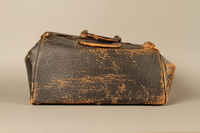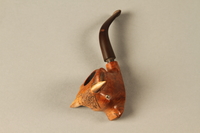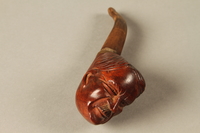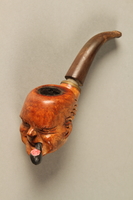Overview
- Brief Narrative
- Stollwerck suitcase used by Berthold Salzmann as he emigrated from Vienna, Austria to England and then to the United States. Berthold and his sister Ernesta were medical students at the University of Vienna throughout the 1930s. On March 13, 1938 Germany annexed Austria and created new legislation that restricted Jewish life. Consequently, Berthold graduated but was unable to practice medicine and Ernesta was unable to graduate. Berthold was selected for a refugee program organized by the Central British Fund for German Jewry, and immigrated to England early in 1939. He was held at the Kitchener refugee camp in East Kent, and then moved to an internment camp on the Isle of Man after the fall of France in May 1940. On June 1, Berthold immigrated to the United States. In June of 1939, Ernesta immigrated to England where she worked as a hospital nurse before immigrating to the United States on November 22, 1942. Berthold’s sister Josefine, and his parents Jakob and Antonie were deported from Vienna to the Kielce ghetto in German occupied Poland. When the ghetto was liquidated in August 1942, they were likely deported with 21,000 other ghetto prisoners to Treblinka killing center and murdered. Berthold and Ernesta both became physicians in the U.S.
- Date
-
use:
1939 June-1940 June
- Credit Line
- United States Holocaust Memorial Museum Collection, Gift of Martha Gay
- Markings
- front, center, metal plate, printed, red ink : Stollwerck
- Contributor
-
Subject:
Berthold Salzmann
Manufacturer: Stollwerck
- Biography
-
Berthold Salzmann (1911-1990) was born in Lwow, Austria-Hungary (now Lviv, Ukraine) to Jakob (Jankel) Salzmann and Antonie (Toni) Zeller Salzmann. He had two sisters, Josefine (Finny b. 1906) and Ernesta (b. 1908). The family moved several times before settling in Vienna where Jakob worked as a civil servant. Berthold and Ernesta pursued careers as physicians, both attending the Medical School of the University of Vienna throughout the 1930s.
On March 13, 1938 Austria was annexed into Germany, in what became known as the Anschluss. German authorities quickly created new legislation that restricted Jewish life. Jews were unable to attend university, were excluded from most professions, and were forced to wear a yellow badge to identify themselves as Jews. This legislation prevented Ernesta from receiving her degree. Berthold was able to graduate from University, but the law prevented him from practicing medicine. On November 9-10, 1938, during the Kristallnacht pogrom, Jews and their businesses, homes, and places of worship were freely and publically attacked by the public and Nazi paramilitary units. After this, the members of the Salzmann family began looking for opportunities to emigrate.
In early 1939, Berthold was selected by the Central British Fund for German Jewry (CBF now World Jewish Relief) for transport out of Austria to England. In the wake of Kristallnacht, the CBF persuaded the British government to allow two rescue missions of Jews from Germany. The first was the Kindertransport, which brought Jewish refugee children to Great Britain. The second was the rescue of 4,000 adult men, many of whom had been arrested in November 1938 and incarcerated in concentration camps. The immigration was allowed as long as the CBF paid for the financial support of the refugees and guaranteed that neither group would remain permanently in Britain. Between February and September 1939, just under 4,000 men were able to escape Austria and Germany through this transport. Berthold, along with the other refugees, arrived at the Kitchener camp in East Kent, England. Also known as the Richborough Transit camp, it was an old World War I base that had been rented by the CBF and turned into a living facility. After the outbreak of the war in September 1939, many of the men in Kitchener joined the British army. After the defeat of France, Kitchener camp was closed and the refugees that were still there were moved to internment camps on the Isle of Man in the Irish Sea. Berthold remained on the Isle of Man until the spring of 1940. On May 22, he left England on the Samaria bound for New York. He arrived in New York City on June 1, 1940. In June 1939, Ernesta was able to leave Austria. She arrived in the Netherlands on June 21, and immigrated to England on June 26. While in England, she worked as a hospital nurse. On November 11, 1940, Ernesta left England for New York on the Western Prince, arriving on November 22.
On February 19, 1941, Berthold’s parents and sister, Jakob, Antonie and Josefine, were issued transport numbers 354, 355 and 356 and deported on Transport Two from the Aspang Railway Station in Vienna, to Kielce, Poland. When they arrived they were initially housed with another Jewish family. On March 31, 1941, a ghetto was established in the city of Kielce and by the end of the year, 27,000 Jews were living there. Conditions in the ghetto were unsanitary and 6,000 Jews died from typhus. From August 20-24, 1942, the ghetto was liquidated and 21,000 Jews were deported to Treblinka killing center where they were murdered. Jakobl, Antonie and Josefine were likely among those murdered at Treblinka. After the war both Ernesta and Berthold remained in the United States and worked as physicians.
Physical Details
- Classification
-
Containers
- Category
-
Luggage
- Object Type
-
Suitcases (aat)
- Genre/Form
- Suitcases.
- Physical Description
- Small rectangular, suitcase with a wooden frame and a fiberboard body wrapped with brown, plastic imitation leather. The exterior layer is riveted on and the corners have hard plastic rounded reinforcements. The base front has a centered, rectangular, metal lock plate with a vertical hasp slot and a raised keyhole. Flanking the lock plate are two silver colored metal mounts that hold the knurled, C shaped, metal handle. Above the lock plate and just below the rim, is a metal plate with red lettering and rounded ends. The lid rim is reinforced with a silver colored metal strip, has a hasp at the front center, and is attached to the base in the back with two metal hinges. The bottom has four rounded, metal feet. The lid interior is lined with brown horizontally striped paper, and the base is lined with gray, vertically striped paper.
- Dimensions
- overall: Height: 5.500 inches (13.97 cm) | Width: 16.000 inches (40.64 cm) | Depth: 9.125 inches (23.178 cm)
- Materials
- overall : leather, plastic, wood, fiberboard, metal, thread, paper, adhesive
Rights & Restrictions
- Conditions on Access
- No restrictions on access
- Conditions on Use
- No restrictions on use
Keywords & Subjects
- Topical Term
- Bags--Materials. Jewish refugees--Austria--Vienna. Holocaust, Jewish (1939-1945)--Austria--Vienna--Personal narratives. Jews--Persecution--Austria--Vienna--Biography. United States--Emigration and immigration--Biography. World War, 1939-1945--Refugees--Great Britain.
- Geographic Name
- Vienna (Austria) Isle of Man. England.
- Corporate Name
- Central British Fund for German Jewry Kitchener Camp for Refugees
Administrative Notes
- Legal Status
- Permanent Collection
- Provenance
- The suitcase was donated to the United States Holocaust Memorial Museum in 2017 by Martha Gay, the daughter of Berthold Salzmann.
- Record last modified:
- 2023-08-24 14:56:53
- This page:
- https://collections.ushmm.org/search/catalog/irn566748
Download & Licensing
In-Person Research
- By Appointment
- Request 21 Days in Advance of Visit
- Plan a Research Visit
- Request to See This Object
Contact Us
Also in Salzmann family collection
The collection consists of documents, correspondence, medical bags, a prayer book, and smoking pipes that relate to the experiences of Berthold Salzmann, his sister Ernesta Spieler, and their family in Austria, and Germany before and during the Holocaust and the United States during and after the Holocaust.
Date: 1911-1953

Medical bag used by an Austrian Jewish physician
Object
Kruse leather medical bag owned by Berthold Salzmann or his sister Ernesta, two Viennese Jewish medical students who immigrated to America as refugees. In the 1930s they were studying to become physicians at the Medical School of the University of Vienna. On March 13, 1938 Germany annexed Austria and created new legislation that restricted Jewish life. Consequently, Ernesta was unable to graduate and Berthold graduated but was unable to practice medicine. In June of 1939, Ernesta immigrated to England where she worked as a hospital nurse before immigrating to the United States on November 22, 1942. Berthold was selected for a refugee program organized by the Central British Fund for German Jewry, and immigrated to England early in 1939. He was held at the Kitchener refugee camp in East Kent, and then moved to an internment camp on the Isle of Man after the fall of France in May 1940. On June 1, Berthold immigrated to the United States. Ernesta and Berthold’s sister Josefine, and their parents Jakob and Antonie were deported from Vienna to the Kielce ghetto in German occupied Poland. When the ghetto was liquidated in August 1942, they were likely deported with 21,000 other ghetto prisoners to Treblinka killing center and murdered. Berthold and Ernesta both became physicians in the U.S.

Zippered leather medical bag used by an Austrian Jewish physician
Object
New Process Co. leather medical bag owned by Berthold Salzmann or his sister Ernesta, two Viennese Jewish medical students who immigrated to America as refugees. In the 1930s they were studying to become physicians at the Medical School of the University of Vienna. On March 13, 1938 Germany annexed Austria and created new legislation that restricted Jewish life. Consequently, Ernesta was unable to graduate and Berthold graduated but was unable to practice medicine. In June of 1939, Ernesta immigrated to England where she worked as a hospital nurse before immigrating to the United States on November 22, 1942. Berthold was selected for a refugee program organized by the Central British Fund for German Jewry, and immigrated to England early in 1939. He was held at the Kitchener refugee camp in East Kent, and then moved to an internment camp on the Isle of Man after the fall of France in May 1940. On June 1, Berthold immigrated to the United States. Ernesta and Berthold’s sister Josefine, and their parents Jakob and Antonie were deported from Vienna to the Kielce ghetto in German occupied Poland. When the ghetto was liquidated in August 1942, they were likely deported with 21,000 other ghetto prisoners to Treblinka killing center and murdered. Berthold and Ernesta both became physicians in the U.S.

Pipe with bowl carved in the shape of a bull’s head
Object
Bull’s head tobacco pipe acquired by Berthold Salzmann’s father-in-law in Germany during the Korean War. This pipe was carved from quality briar wood, the best material for pipes. Berthold and his sister Ernesta were medical students at the University of Vienna throughout the 1930s. On March 13, 1938 Germany annexed Austria and created new legislation that restricted Jewish life. Consequently, Berthold graduated but was unable to practice medicine and Ernesta was unable to graduate. Berthold was selected for a refugee program organized by the Central British Fund for German Jewry, and immigrated to England early in 1939. He was held at the Kitchener refugee camp in East Kent, and then moved to an internment camp on the Isle of Man after the fall of France in May 1940. On June 1, Berthold immigrated to the United States. In June of 1939, Ernesta immigrated to England where she worked as a hospital nurse before immigrating to the United States on November 22, 1942. Berthold’s sister Josefine, and his parents Jakob and Antonie were deported from Vienna to the Kielce ghetto in German occupied Poland. When the ghetto was liquidated in August 1942, they were likely deported with 21,000 other ghetto prisoners to Treblinka killing center and murdered. Berthold and Ernesta both became physicians in the U.S.

Tobacco pipe with a bowl carved into the shape of Hitler’s head
Object
Tobacco pipe with a bowl in the shape of Adolf Hitler’s head acquired by the father in law of Berthold Salzmann from Germany during the Korean War. This pipe was carved from quality briar wood, the best material for pipes. Berthold and his sister Ernesta were medical students at the University of Vienna throughout the 1930s. On March 13, 1938 Germany annexed Austria and created new legislation that restricted Jewish life. Consequently, Berthold graduated but was unable to practice medicine and Ernesta was unable to graduate. Berthold was selected for a refugee program organized by the Central British Fund for German Jewry, and immigrated to England early in 1939. He was held at the Kitchener refugee camp in East Kent, and then moved to an internment camp on the Isle of Man after the fall of France in May 1940. On June 1, Berthold immigrated to the United States. In June of 1939, Ernesta immigrated to England where she worked as a hospital nurse before immigrating to the United States on November 22, 1942. Berthold’s sister Josefine, and his parents Jakob and Antonie were deported from Vienna to the Kielce ghetto in German occupied Poland. When the ghetto was liquidated in August 1942, they were likely deported with 21,000 other ghetto prisoners to Treblinka killing center and murdered. Berthold and Ernesta both became physicians in the U.S.

Tobacco pipe with a bowl carved into the shape of Churchill’s head
Object
Tobacco pipe with a bowl shaped like Winston Churchill’s head acquired by the father in law of Berthold Salzmann from Germany during the Korean War. This pipe was carved from quality briar wood, the best material for pipes. Berthold and his sister Ernesta were medical students at the University of Vienna throughout the 1930s. On March 13, 1938 Germany annexed Austria and created new legislation that restricted Jewish life. Consequently, Berthold graduated but was unable to practice medicine and Ernesta was unable to graduate. Berthold was selected for a refugee program organized by the Central British Fund for German Jewry, and immigrated to England early in 1939. He was held at the Kitchener refugee camp in East Kent, and then moved to an internment camp on the Isle of Man after the fall of France in May 1940. On June 1, Berthold immigrated to the United States. In June of 1939, Ernesta immigrated to England where she worked as a hospital nurse before immigrating to the United States on November 22, 1942. Berthold’s sister Josefine, and his parents Jakob and Antonie were deported from Vienna to the Kielce ghetto in German occupied Poland. When the ghetto was liquidated in August 1942, they were likely deported with 21,000 other ghetto prisoners to Treblinka killing center and murdered. Berthold and Ernesta both became physicians in the U.S.
Berthold Salzmann collection
Document
Documents and correspondence illustrating the experiences of Berthold Salzmann (donor's father), a Viennese Jewish physician who fled to the United Kingdom and then the United States. Also included are materials relating to Ernesta Spieler (Berthold's sister) who was also a physician.
Book of Exodus primer owned by a Jewish Austrian physician
Object
Religious primer book owned by the Salzmann family in Vienna, Austria before 1939. The book contains the story of Moses with commentary by Rashi, a medieval Jewish religious commentator. Berthold and Ernesta Salzmann were brother and sister who were studying to become physicians at the Medical School of the University of Vienna. On March 13, 1938 Germany annexed Austria and created new legislation that restricted Jewish life. Consequently, Ernesta was unable to graduate and Berthold graduated but was unable to practice medicine. In June of 1939, Ernesta immigrated to England where she worked as a hospital nurse before immigrating to the United States on November 22, 1942. Berthold was selected for a refugee program organized by the Central British Fund for German Jewry, and immigrated to England early in 1939. He was held at the Kitchener refugee camp in East Kent, and then moved to an internment camp on the Isle of Man after the fall of France in May 1940. On June 1, Berthold immigrated to the United States. Ernesta and Berthold’s sister Josefine, and their parents Jakob and Antonie were deported from Vienna to the Kielce ghetto in German occupied Poland. When the ghetto was liquidated in August 1942, they were likely deported with 21,000 other ghetto prisoners to Treblinka killing center and murdered. Berthold and Ernesta both became physicians in the U.S.



